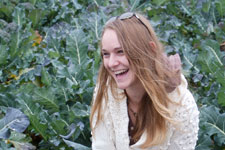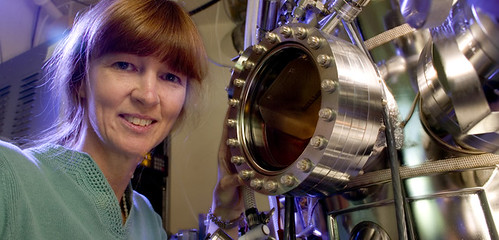Dr. Anne Nolin’s research is featured today on the front cover of The Oregonian.
At risk snow
February 8th, 2008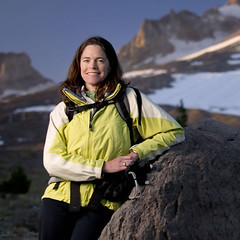 Dr. Anne Nolin studies “at risk snow” as a member of our Climate Change Group in Geosciences Department. The department was ranked 6th in the country this year.
Dr. Anne Nolin studies “at risk snow” as a member of our Climate Change Group in Geosciences Department. The department was ranked 6th in the country this year.
She is one of the scientists in the IPCC to share in the Nobel Peace Prize this year.
“I chose to study snow because it is an amazingly beautiful, pure substance that is so sensitive to small changes in temperature – it can simultaneously exist as liquid, vapor and solid. When viewed by the human eye, snow is the brightest substance on our planet but at other wavelengths, beyond our vision, it becomes dark even to the point of becoming the blackest substance on earth. What I’ve learned through my work is that snow and ice are transitory and that their interactions with climate involve complex and sometimes rapid feedbacks.”
You can read more about Anne here.
Ernest and Pauline Jaworski Summer Research Internship for Undergraduates in Plant Sciences
February 8th, 2008Ernest (College of Science ’50 and ’52) and Pauline (College of Science ’50) Jaworski of St. Louis, MO put in place a grant for summer internships almost 10 years ago. They have since endowed the account, guaranteeing this support for perpetuity.
Terra featured a story on scholarships in the Winter 2008 article, and gave us a glimpse into the life of a student benefiting from the Jaworski’s philanthropic vision.
Nikki Marshall
Year and discipline: Senior, Bioresource Research
Hometown: Portland, Oregon
Scholarship: The Jaworski Scholarship has opened up opportunities or me in sustainable, organic farming and ecosystem restoration. Financially, it has enabled me to pay for childcare for my daughter. (Note: Marshall has also received the E.R. Jackman Scholarship, support from the Oregon Seed Trade Association and an award from the American Seed Trade Association with Future Seed Executives.)
Inspiration: My daughter Trinity is 8 years old. She is always asking questions and giving me hope.
Career goal: To own a farm and to restore lands harmed by invasive species or toxic chemicals.
Academic focus: I have been learning how to control seeds through heat treatments and consumption by beetles. Seeds of invasive species and other weeds pose problems for agriculture and environmental restoration.
Tell the truth: You wonder what ONAMI is and why you should care
February 6th, 2008A recent article in the Corvallis Gazette-Times about Oregon Nanoscience and Microtechnologies Institute (ONAMI) explains why the support of higher education is so key to the economic health of Oregon in the global market:
Oregon needs to start ramping up its support of higher education, or else the state will be unable to compete in the global marketplace. That’s both the fear and the mission of Skip Rung, executive director of the Oregon Nanoscience and Microtechnologies Institute in Corvallis. “This is the one thing that Oregon still doesn’t get enough,” Rung said during an interview Tuesday. “Higher education is absolutely critical to any region’s economic future.”
ONAMI’s mission is to support new research and to provide seed money to help small tech companies grow. Without its academic partners, the project couldn’t succeed. Likewise, Rung said, Oregon won’t be able to thrive without the research and development at public universities, which provide the talent and the ideas that produce new technology.
Read the entire article here: Tech exec: Higher Ed Lagging, by Theresa Hogue, Gazette-Times reporter.
John E. Smith and Willetta M. Smith Fellowship in Geosciences
February 4th, 2008
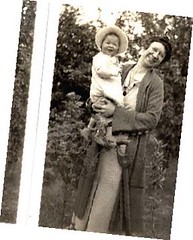
John and Willetta, each holding their daughter, Joan.
Having just gotten the blog up and running, we’re backlogged on announcements of some of the fantastic gifts that have been made to the College of Science during the Campaign for OSU.
Joan and Chuck McDougald of Corvallis made a commitment in honor of Joan’s parents, John E. and Willetta M. Smith. They designated The College of Health and Human Sciences and the Department of Geosciences. The fellowship in geosciences will support graduate students, which is a top priority for the department. Great graduate students elevate the undergraduate experience and support the research being conducted by our faculty.
Here’s a lovely story about this multi-generational OSU family and their philanthropy:
John E. Smith and Willetta M. Smith Fellowship in Geosciences.
Circulating on the Geosciences listserv this week.
February 4th, 2008[youtube=http://www.youtube.com/watch?v=mF_anaVcCXg&rel=1]
Note to Oregon: Lessons learned from Banda Aceh
January 20th, 2008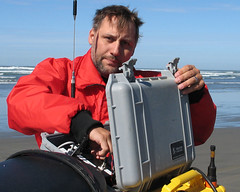 Beaches Ravaged by Tsunami Still Eroding
Beaches Ravaged by Tsunami Still Eroding
By David Stauth, 541-737-0787
Contact: Peter Ruggiero, 541-737-1239
CORVALLIS, Ore. – The catastrophic damage of the 2004 Indian Ocean earthquake was mostly done within a few hours, but that was just the beginning of a different process that may take up to a decade or more to complete – the stabilization of new beaches and landforms in areas ravaged by this disaster.
In continued studies, researchers at Oregon State University and the U.S. Geological Survey are finding that the beaches may continue to shift and change for several more years, as the lands adjust both to the tsunami impacts and the sudden drop of some nearby land by three to six feet.
Meanwhile, some roads constructed in the push for recovery after the disaster already are being threatened by eroding beaches and lapping water. Houses have been rebuilt on stilts in areas that properly should now be considered ocean, not land. And beach experts are closely studying this process – not only to learn more, but to make sure that when the Pacific Northwest tries some day to recover from its own massive tsunami, the decisions will be informed by good science.
 “In Banda Aceh, the city most severely hit by the tsunami, some people are using fill, raised roadbeds and stilts to build their homes in what is essentially an intertidal zone,” said Peter Ruggiero, an OSU assistant professor of geosciences. “It’s amazing the energy they are putting into this, but it is apparent that much of this land may just disappear. You can see palm trees in the ocean, on what used to be dry land. Right now some areas look like a little Venice.
“In Banda Aceh, the city most severely hit by the tsunami, some people are using fill, raised roadbeds and stilts to build their homes in what is essentially an intertidal zone,” said Peter Ruggiero, an OSU assistant professor of geosciences. “It’s amazing the energy they are putting into this, but it is apparent that much of this land may just disappear. You can see palm trees in the ocean, on what used to be dry land. Right now some areas look like a little Venice.
“And with some regularity, when we were looking at a new highway in Indonesia that already needs rip-rap to prevent the ocean from claiming it, I was visualizing Highway 101 on the Oregon Coast,” Ruggiero said. “Our input may be too late to help the Indonesians in their recovery from this disaster, but hopefully we may learn a lot here that will some day help the U.S. recover from the tsunami in our future.”
There’s little realization, Ruggiero said, that after a tectonic and geologic event the magnitude of the one in Indonesia, the ocean will take years to adjust to a new equilibrium, one in which shorelines are largely stable and neither eroding or building. And predicting exactly what the ocean will give, and what it will take away, is a very new science – one that will get a major boost from what is now being learned during the Indonesian recovery. The research is being funded by the U.S. Geological Survey.
“Never before with modern scientific monitoring tools have we been able to so rigorously study a tsunami disaster such as this, literally on film from the moment it occurred to many years later,” Ruggiero said. “There have already been some surprises in places, where we’ve found the sand being moved and then re-distributed, and we’ll find out more as we go. But this process is nowhere near complete yet.”
On Dec. 26, 2004, a 9.2 magnitude earthquake triggered one of the deadliest natural disasters in modern world history, which included tsunami waves that reached up to 100 feet high. The waves scoured the ocean floor with their enormous energy and deposited huge amounts of sand and debris some distances inland, while other material was stripped away and washed out to sea. More than 225,000 people died in 11 countries.
“We have been able to study both the ocean floor and the inland effects, and are monitoring changes through time,” Ruggiero said. “We’ve discovered sandbars created by the tsunami in some shallow ocean waters that otherwise would not be there, and they appear to be gradually rebuilding some of the beaches.”
But receiving less attention at the time of the disaster, Ruggiero said, was the subsidence of some nearby areas by three to six feet – a result of land that had been “pushed up” by a subduction zone for centuries, only to drop back down suddenly during the earthquake. This resulted in an instant change of sea level over broad areas of coastal Indonesia that is still working itself out.
“As a result of the coastal subsidence, we’re still seeing beaches in retreat, which may continue for some time,” Ruggiero said. “Spits and inlets will form. We’re going to try to understand the forces at work and make predictions about where the ultimate shoreline will be, then come back in later years and see if we were right or not. We should learn a lot from this process.”
That knowledge, he said, may help scientists not only to better understand past tsunamis, but also to assist in recovery from those yet to occur. And one of the prime candidates for such an event is the Pacific Northwest coast of the United States and Canada, where the Cascadia Subduction Zone is nearly a geologic twin to its Indonesian counterpart. It’s believed that this zone has had several subduction zone earthquakes in the past 1,000 years, the last of which may have occurred in 1700.
“We’re already learning, just from what we’ve observed in Indonesia, that you must be very cautious what setbacks to allow for new construction and rebuilding after a major tsunami or land subsidence,” Ruggiero said. “Hopefully we’ll be able to develop computer models that will allow us to predict the final shape of the shorelines with more accuracy. And those shores may be dramatically different that the ones we now have.”
Vitamin E trials not so much
January 18th, 2008Balz Frei, the Director of the Linus Pauling Institute (which will share the new science center with our chemistry faculty), and a member of the Department of Biochemistry and Biophysics, has this to add to the ongoing debate on the efficacy of Vitamin E:
http://www.functionalingredientsmag.com/fimag/articleDisplay.asp?strArticleId=1577&strSite=FFNSite
What to ants and juicy berries have in common, you ask?
January 18th, 2008Dr. George Poinar, Jr., a member of our Department of Zoology, has come out with this answer, circulating today. George is known as the world’s authority on the nematodes that parasitize insects.
http://www.berkeley.edu/news/media/releases/2008/01/16_ants.shtml
Our Department of Zoology was ranked sixth in the nation in the last report by the Chronicle of Higher Education.
Quantum Leaps in Physics
January 17th, 2008 The Physics Department is celebrating it’s 100th anniversary this year. At right, a photo, taken sometime in 1928, of Professor Jordan (left), who built the first radio transmitter, KFDJ, 5 watts. Dr. Weniger (right) founded the department in 1908.
The Physics Department is celebrating it’s 100th anniversary this year. At right, a photo, taken sometime in 1928, of Professor Jordan (left), who built the first radio transmitter, KFDJ, 5 watts. Dr. Weniger (right) founded the department in 1908.
Also, chair and professor emeritus, Ken Krane, has been selected by the Honors College as 2008’s Eminent Professor.
In addition, the College of Science is pleased to announce the inception of the Ben and Elaine Whiteley Endowed Fund in Materials Research, recently established by long-time friends, donors, and volunteers, Ben and Elaine Whiteley. Elaine’s father was Dr. Edwin Yunker. Professor Yunker was a member of the OSU physics faculty from 1925 to 1968 and was department chair from 1949 to 1966. The Yunker lecture was established in his honor. Ben and Elaine live in Portland, and are delighted to have made this contribution in support of the materials science program, which has also been counted toward the challenge made by the Valley Foundation for the College of Science to raise $15 million in program support.
Dr. Janet Tate is one of the lead faculty members in the Materials Science group.
Finally, the Paradigms in Physics classroom remodel for first- and second-year students is on the way to becoming a reality.
That’s all for this nanosecond!

